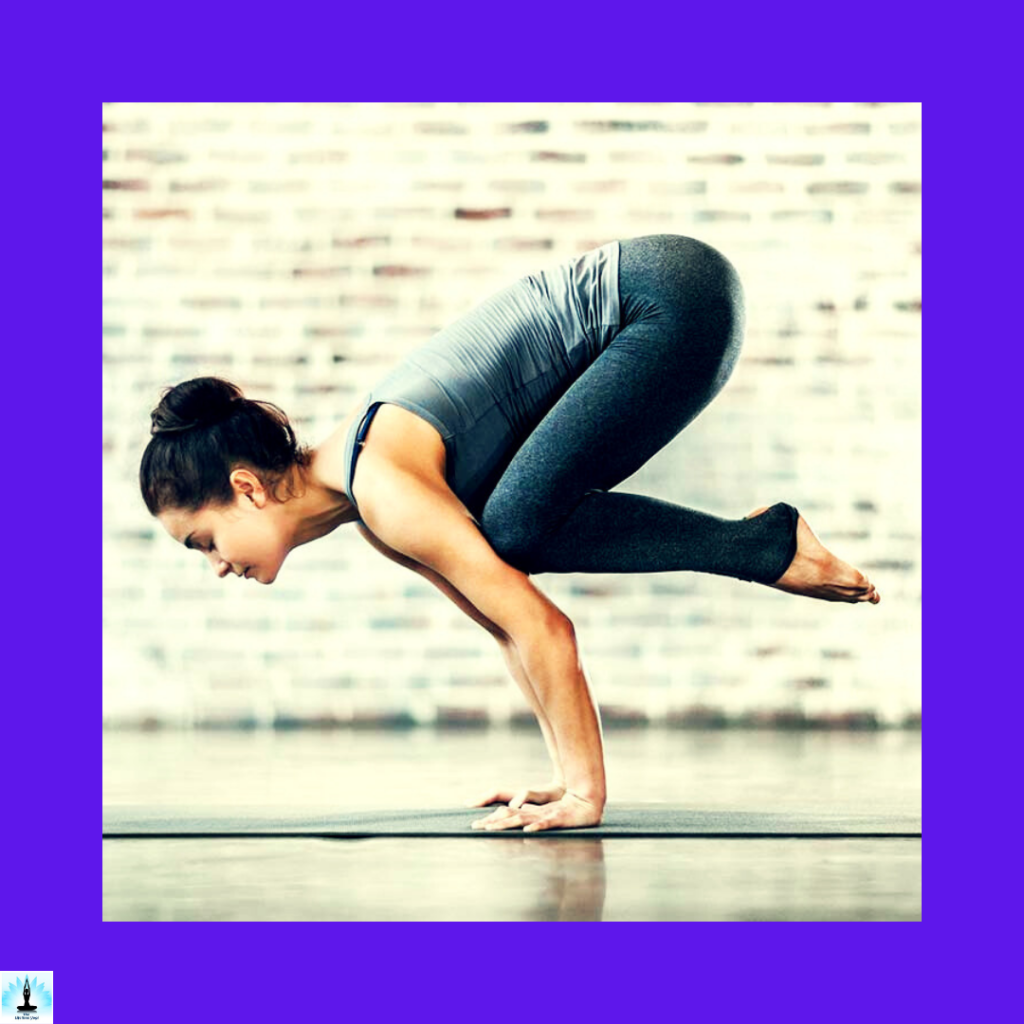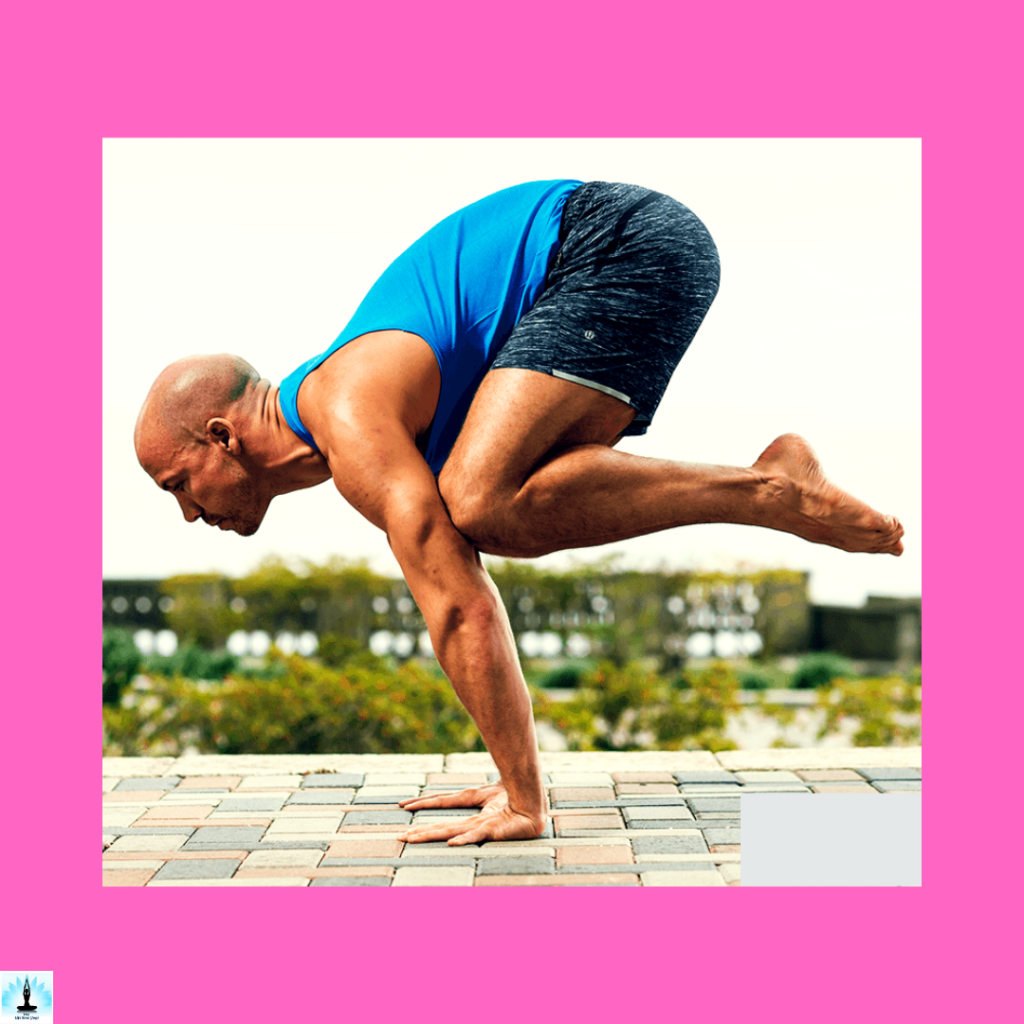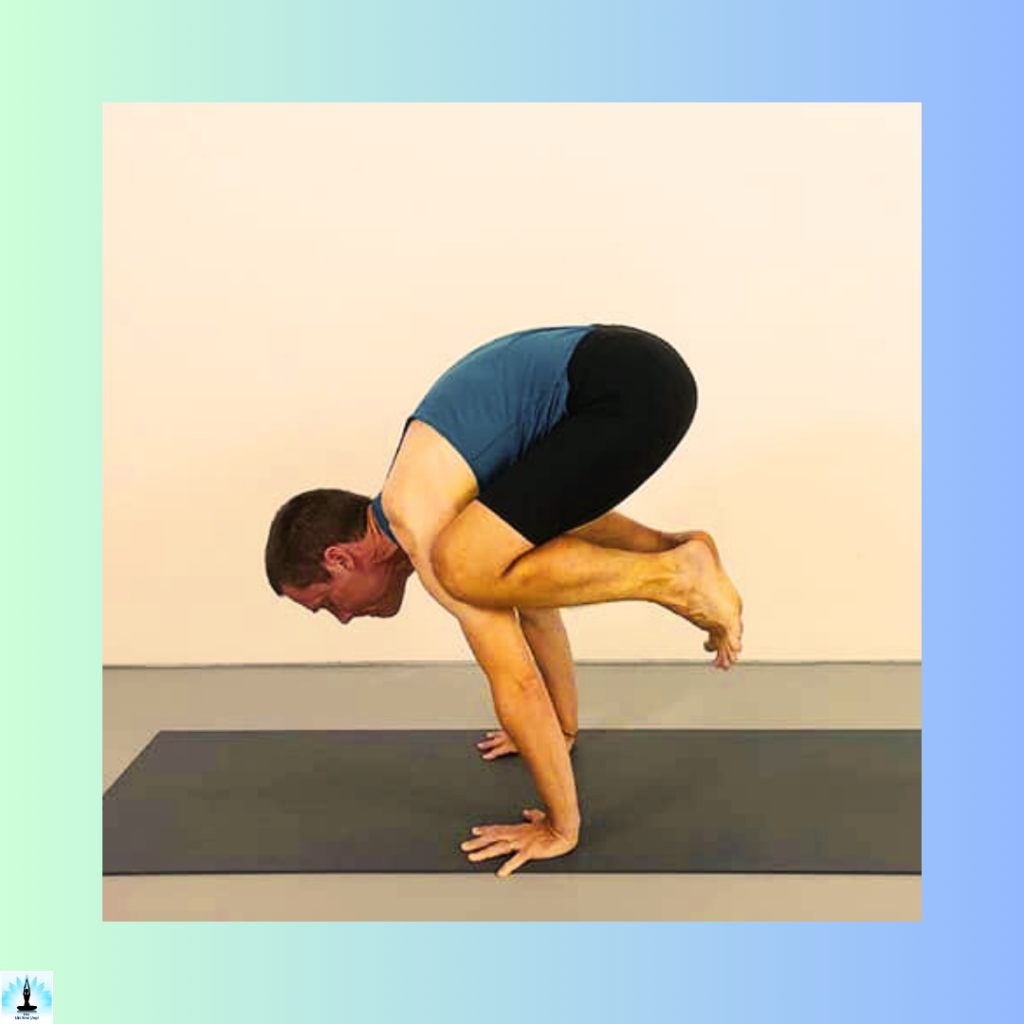Kakasana is an arm balancing pose that belongs to the family of Bakasana (Crow Pose) variants. In Sanskrit, “kaka” means crow, and “asana” means posture. True to its name, Kakasana mirrors the stance of a crow about to take flight, symbolizing the soaring spirit and the courage to face challenges with grace.
Table of Contents
The yogic philosophy of the Kakasana
The yogic philosophy of Kakasana, also known as Crow Pose, goes beyond a mere physical posture to encompass profound spiritual teachings. This arm-balancing pose symbolizes the delicate balance between effort and surrender, urging practitioners to find harmony within themselves and the world around them.

Through Kakasana, one learns the importance of concentration and mindfulness, as the pose demands complete focus to maintain stability and prevent falling. The act of surrendering fears and doubts while trusting one’s strength parallels the essence of non-attachment and letting go in yogic philosophy.
Step-by-Step Instructions of Kakasana (Crow Pose)
While Kakasana may seem daunting at first, with patience and practice, you can conquer this empowering pose. Here’s a step-by-step guide to help you take flight in Crow Pose:

- 1. Warm-Up: As with any yoga practice, it’s essential to warm up your body before attempting Kakasana. Focus on stretching your wrists, arms, and shoulders, as they’ll bear much of your weight in the pose. Also, engage in some hip-opening exercises to prepare your body for the balancing act.
- 2. Foundation: Start in a squatting position with your feet hip-width apart. Place your palms firmly on the ground, shoulder-width apart, and spread your fingers wide to create a stable foundation.
- 3. Bend Your Elbows: Slowly bend your elbows, bringing them closer to your body. Your forearms should now be pointing forward.
- 4. Place Your Knees: Gently place your knees on the back of your upper arms, as high up as possible. The connection between the knees and arms is crucial for maintaining balance.
- 5. Shift Your Weight: Shift your weight forward, transferring it from your feet to your hands. Gradually lift one foot off the ground, and then the other. As you progress, you’ll find that you can lift both feet simultaneously.
- 6. Engage Your Core: Engage your core muscles to help stabilize your body in the pose. Draw your belly button toward your spine to avoid sinking into your shoulders.
- 7. Gaze Ahead: Keep your gaze fixed on a point slightly ahead of you to maintain balance and focus.
- 8. Breathe: Remember to breathe deeply and evenly throughout the pose. Holding your breath will only add tension and hinder your ability to find balance.
- 9. Hold and Release: As a beginner, holding Kakasana for a few seconds is an accomplishment. Gradually increase the duration as your strength and confidence grow. To release, gently place your feet back on the ground and come back to a squatting position.
The Benefits of Kakasana
Beyond its aesthetic appeal, Kakasana offers numerous benefits that extend to all aspects of your being:

- 1. Strengthens the Arms and Wrists: As an arm balancing pose, Kakasana tones and strengthens the muscles in your arms, forearms, and wrists, improving their flexibility and stability.
- 2. Tones the Abdominal Muscles: The engagement of your core muscles in Crow Pose helps tone your abdominal region, promoting better digestion and posture.
- 3. Develops Focus and Balance: The concentration required to maintain the pose enhances mental focus and stability, fostering a sense of balance in your thoughts and emotions.
- 4. Builds Confidence: As you progress in Kakasana, you’ll experience a boost in self-confidence and a sense of accomplishment, knowing that you can overcome challenges with practice and perseverance.
- 5. Therapeutic for the Mind: Like many yoga poses, Kakasana has a calming effect on the mind, reducing stress and anxiety while promoting mindfulness.
Advance Variations of Kakasana
Once you have mastered the foundational Kakasana (Crow Pose), there are several advance variations that you can explore to deepen your practice and challenge yourself further. These advanced variations require increased strength, flexibility, and balance. Always remember to warm up properly and practice with caution, progressing gradually to avoid injuries.
Poses Related to Kakasana
Preparatory Poses
1. Bakasana (Crane Pose)
Often used interchangeably with Kakasana, Bakasana is a slightly more challenging version. Instead of placing the knees on the back of the upper arms, in Crane Pose, the knees rest higher up on the upper arms, closer to the armpits. This variation demands greater core engagement and deeper hip flexion.
2. Parsva Bakasana (Side Crane/Crow Pose)
In this variation, the body is lifted into Bakasana, and then the practitioner shifts their weight to one side, twisting the torso to open towards the opposite side. One arm remains straight, and the other arm bends, creating a twist in the pose. This variation requires increased strength and flexibility in the obliques and shoulders.
Follow-up Poses
1. Eka Pada Bakasana (One-Legged Crow Pose)
In Eka Pada Bakasana, one leg is extended straight back while the other leg remains tucked into the chest. This variation challenges not only arm and core strength but also hip flexibility and balance.
2. Astavakrasana (Eight-Angle Pose)
Astavakrasana combines elements of arm balancing and twisting. In this pose, the legs are placed to one side of the body, and the arms create a secure foundation for the body to rest on. The challenge lies in maintaining balance and finding the twist while engaging the core muscles.
Therapeutic Applications of Kakasana
- Kakasana, or Crow Pose, is not only an invigorating arm-balancing posture but also possesses therapeutic applications that benefit both the physical and mental aspects of practitioners.
- From a therapeutic perspective, this pose can assist in relieving mild anxiety and stress by encouraging mindfulness and promoting a sense of accomplishment when successfully executed.
- Furthermore, as Kakasana requires engaging the abdominal muscles, it aids in stimulating the digestive organs, potentially supporting digestive health.
- When practiced with proper alignment and mindfulness, Kakasana can be a transformative posture, offering both physical vitality and a calm, centered mind.
Contraindications and Cautions of Kakasana
While Kakasana (Crow Pose) can be a transformative and empowering yoga posture, it is essential to approach it with caution and awareness, as it may not be suitable for everyone.
- Individuals with wrist, elbow, or shoulder injuries should avoid practicing Kakasana, as the pose places significant pressure on these areas.
- Additionally, those with carpal tunnel syndrome or other wrist-related issues should refrain from attempting this arm-balancing pose.
- Pregnant women and individuals with high blood pressure or heart conditions should avoid Kakasana, as it involves the inversion of the body and can strain the cardiovascular system.
- Practitioners with lower back or neck injuries should also be cautious, as incorrect alignment in the pose could exacerbate these conditions.
FAQs on Kakasana
How long should you hold Kakasana?
The duration of holding Kakasana, or Crow Pose, varies depending on individual strength and experience. For beginners, it is advisable to start with holding the pose for a few seconds, gradually increasing the duration as strength and confidence grow. Intermediate practitioners may aim for 10-30 seconds, while advanced yogis may hold the pose for a minute or more. However, it is crucial to listen to your body and avoid overstraining. Regular practice and patience will naturally improve your ability to hold Kakasana for more extended periods.
How can I improve my balance in Kakasana?
To improve balance in Kakasana, focus on engaging your core muscles, find a steady gaze (drishti) ahead of you, and distribute your weight evenly through your hands and fingers. Regular practice and patience will help develop better balance over time.
Can Kakasana be a part of a regular yoga practice?
Yes, Kakasana can be included in a regular yoga practice to improve strength, balance, and focus. It can be incorporated into sequences or practiced as a standalone pose.
How can I safely transition into and out of Kakasana?
To transition into Kakasana, start in a squatting position, place your hands shoulder-width apart on the mat, bend your elbows, and place your knees on the back of your upper arms. Gently lift your feet off the ground, finding balance in your hands. To come out of the pose, lower your feet back to the ground and return to a squatting position. Always maintain control and avoid abrupt movements to prevent injuries.
Is Bakasana crow or crane?
Bakasana is often referred to as Crow Pose. In some cases, it is also known as Crane Pose. The confusion arises due to the similarities in the arm balance and the way the body appears to be imitating the posture of a crow or a crane about to take flight.
What muscles are used in Kakasana?
Kakasana primarily engages the muscles of the arms, especially the triceps and the muscles of the forearms and wrists, as they support the weight of the body. The core muscles, including the rectus abdominis and obliques, play a significant role in stabilizing the body during the pose. Additionally, the hip flexors, quadriceps, and adductors are activated to lift and balance the legs.
What are the benefits of Kakasana?
Kakasana, or Crow Pose, offers a plethora of benefits. It strengthens the arms, wrists, and core muscles, improving upper body strength and stability. The pose also enhances concentration, focus, and balance. Practicing Kakasana can have a calming effect on the mind, reducing stress and anxiety. Additionally, it stimulates the abdominal organs, aiding digestion. Overall, Kakasana is an empowering posture that combines physical strength with mental focus and tranquility.
What is the Indian name of Crow Pose?
The Indian name of Crow Pose is “Kakasana.” In Sanskrit, “kaka” means crow, and “asana” means posture, thus giving rise to the name Kakasana.
Bakasana and Kakasana same or different?
Bakasana and Kakasana are often used interchangeably to refer to Crow Pose. Both terms essentially describe the same yoga posture, which is an arm balancing pose with the knees placed on the back of the upper arms.
What level of yoga is crow pose?
Crow Pose, or Kakasana, is generally considered an intermediate-level yoga pose. While it requires a certain level of arm and core strength, it is achievable for most practitioners with regular practice and proper alignment. Beginners may find it challenging initially, but with patience and persistence, they can progress toward mastering this empowering pose.
In Conclusion
Kakasana, the Crow Pose, invites us to rise above our doubts and fears, spreading our wings wide to embrace the challenges that come our way. As we master this graceful posture, we not only cultivate physical strength but also develop mental resilience and spiritual growth. So, spread your feathers, take flight, and let Kakasana be your guide on the journey of self-discovery and transformation. Happy flying!
Further reading on Kakasana
References
- Mittra, Dharma (21 March 2003). Asanas: 608 Yoga Postures. New World Library. ISBN 978-1-57731-402-8. Retrieved 25 June 2011.
- Iyengar, B. K. S. (1987) [1966]. Light on Yoga. New York: Schocken Books. pp. 315–317. ISBN 0-8052-0610-8.
- Vishnu-devananda, Swami (1988) [1960]. The Complete Illustrated Book of Yoga. Three Rivers Press. p. plate 110. ISBN 0-517-88431-3.
- Long, Ray (August 2009). The Key Muscles of Yoga: The Scientific Keys, Volume 1. Greenleaf Books. p. 230. ISBN 978-1-60743-238-8. Retrieved 9 April 2011.
- Srinivasa, Narinder (2002). Gharote, M. L.; Devnath, Parimal; Jha, Vijay Kant (eds.). Hatha Ratnavali Srinivasayogi
